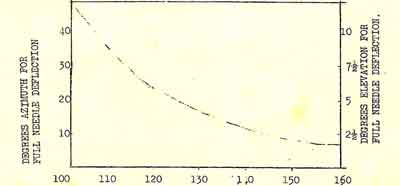RESTRICTED. Page 25
Zero Reader Presentation.
This is situated on the starboard of the instrument panel below
the D.M.E. dial.
Two needles, pivoted at 12 o'clock and 9 o'clock swing towards
the direction of the target. Too small flags at 6 o'clock and
3 o'clock disappear when the associated needle is in operation.
4. Operation.
The homing indication is derived from the phase difference between the
signals produced in two separate aerials by selected transmission. The signals
from the two whip aerials mounted 12 inches apart on the spine of the Hunter
are used for indications in azimuth. For indications in elevation the
starboard aerial is used in conjunction with another whip aerial mounted on
the underside of the fuselage.
The operational range is up to 200 miles air to air above 10,000 feat.
5. Relationship between needle sweep and angle off.

Signal frequency in m/cs.
Fig. 1. Full needle deflection plotted against frequency.
The lower the frequency the more angle off the target will be for a
full needle sweep. This is illustrated in figure 1 above. Since the scaling
of the indicator is liniar it is possible to tell the "angle off" of the
target at any indication less than full needle deflection.
Example.
On 110 m/cs. full needle sweep is about 32° angle off and therefore since
there are four dots between the centre and edge of the indicator each dot
represents eight degrees.
A thorough knowledge of this is essential if a cut off vector on the
target is to be obtained. Without this cut off vector the fighter pilot will
be lucky not to fall into line astern several miles behind the target.
/6. Points
RESTRICTED. | 






